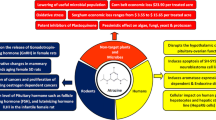Abstract
Chloroplast thylakoids are used as biological units to determine herbicides in different kinds of water samples as well as in aqueous extracts of compost, soil or food samples. The thylakoid bioassy shows clearly inhibition of fluorescence yield in the presence of photosystem II specific herbicides. Due to this method the ecotoxicological effect of samples with unknown pollutants can be tested fast and cost effective. It has been proven that all photosynthetic active compounds are recorded at the same time because only additive interactions occur. Therefore, the contamination level can be expressed as cumulative parameter for photosystem II active substances. Application was improved clearly by the addition of the radical scavenger sodium ascorbate to the isolation media and by a higher concentration of the measuring medium. A new data evaluation method is described yielding in a lower detection limit of 0.4 μg diuron/1. The guidelines for the quality of water for human consumption with an allowable concentration of pesticides in groups is 0,5 μg/1 [1,2] and can be controlled with the thylakoid bioassay without performing any preconcentration steps.
Similar content being viewed by others
References
1. Trinkwasserverordnung (1986): Verordnung über Trinkwassser und über Wasser für Lebensmittelbetriebe vom 22.5.1986. BGBl.Ip. 760
European Economy Community (1985): Drinking water directive, no. 80/778/EEC
J. Bausch-Weis;S. Overmeyer;H. Schnabl (1994): Chloroplastenthylakoide als Herbiziddetektoren im Trinkwasser. Vom Wasser, 83, 235–241
G.M. Zimmermann;G.N. Kramer;H. Schnabl (1996): Lyophilisation of Thylakoids for improved handling in a bioassay. Environ. Toxicol. Chem., 15, 1461–1463
A. Larson (1988): The antioxidants of higher plants. Phytochemistry, 27, 969–978
W.S. Cohen;D.R. Baxter (1990): Sulfhydryl reagents and energy-linked reactions in monocot thylakoids. Plant Physiol., 93, 1005–1010
H.H. Robinson;C.F. Yocum (1980): Cyclic photophosphorylation reactions catalyzed by ferredoxin, methyl viologen and anthraquinone sulfonate. Biochim. Biophys. Acta, 590, 97–106
D.I. Arnon (1949): Copper enzymes in isolated chloroplasts polyphenoloxidase in Beta vulgaris. Plant Physiol., 24, 1–15
U. Schreiber;W. Bilger (1993): Progress in chlorophyll fluorescence research — Major developments during the past years in retrospect. In: Progress in Botany,H. D. Behnke et al. (Eds.), Vol. 54. Springer Berlin, Heidelberg, Germany, pp. 151–173
U. Takahama (1982): Suppression of carotenoid photobleaching by kaempferol in isolated chloroplasts. Plant Cell Physiol., 23, 859–864
G.P. Evans;M.G. Briers;D.M. Rawson (1986): Can biosensors help to protect drinking water? Biosensors, 2, 287–300
Author information
Authors and Affiliations
Rights and permissions
About this article
Cite this article
Trapmann, S., Etxebarria, N., Schnabl, H. et al. Progress in herbicide determination with the thylakoid bioassay. Environ. Sci. & Pollut. Res. 5, 17–20 (1998). https://doi.org/10.1007/BF02986369
Received:
Accepted:
Issue Date:
DOI: https://doi.org/10.1007/BF02986369




